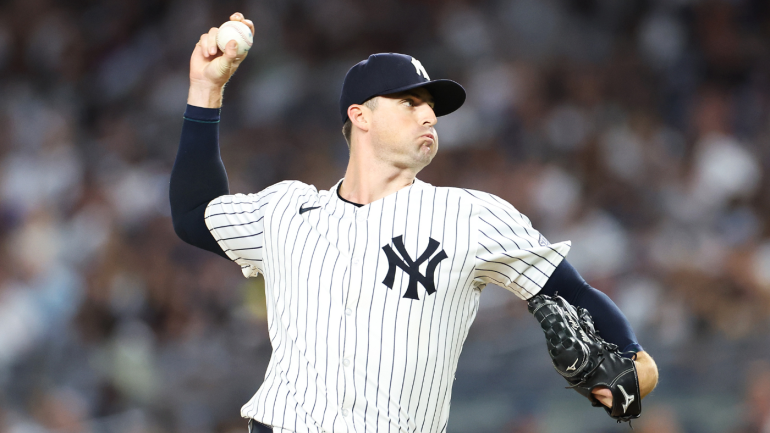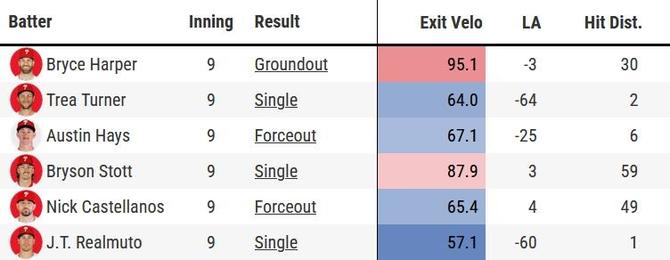
NEW YORK -- At 73-53, the New York Yankees have the third-best record in the American League and are a half-game behind the Baltimore Orioles in the AL East. The Yankees and Orioles are having a summer mid-off: New York is 19-21 since July 1 and the O's are 21-22. They've played hot potato with first place for several weeks now.
Both clubs have had bullpen trouble in recent weeks and for the Yankees, closer Clay Holmes tends to find himself on the mound for the biggest meltdowns. Holmes blew his MLB-leading tenth save in the Little League Classic on Sunday night. That's the most blown saves by a Yankee in a single season since Dave Righetti had 13 in 1987.
"I will leave (save situations) open and try and put these guys in places where they match up really well," Yankees manager Aaron Boone said Tuesday. "... I expect it to be Clay on a lot of nights, but if I feel like that really good matchup for Clay is in the eighth on a given night, where it serves him or lines up better, then I'll be open to doing that a little bit more than I have."
A few hours later, Holmes entered with the score tied in the ninth inning against the Cleveland Guardians (CLE 9, NYY 5 in 12 innings), and struck out three of the four batters he faced. That's a pretty standard closer situation. There's no longer the possibility of a save situation when the score is tied going into the ninth inning at home. Holmes was again used in a closer's situation.
For the season, Holmes has a 2.82 ERA with a 67.6% ground ball rate that is tops among the 351 pitchers with at least 40 innings. He has been the game's premier ground-ball pitcher since joining the Yankees in a deadline trade with the Pittsburgh Pirates in 2021. The surface numbers are strong, but, at the end of the day, 10 blown saves is 10 blown saves.
What's going on with Holmes and what alternatives do the Yankees have in the ninth inning? Let's dig into it now.
Not all blown saves are created equal
This is not to excuse the 10 blown saves, because at the end of the day, you have to get the outs you're asked to get. It is only fair to have the full context though. For example, on April 3, Holmes was hit with a blown save because an Anthony Volpe throwing error and an infield single allowed the automatic runner to score in the tenth inning. (The Yankees won the game anyway.)
Three times -- May 28 vs. Los Angeles Angels, July 26 vs. Boston Red Sox, and Aug. 4 vs. Toronto Blue Jays -- Holmes was charged with a blown save in the eighth inning after entering with multiple runners on base and being asked to get a four- or five-out save. He was put in to clean up someone else's mess. On July 30, Holmes gave up a run and blew the save on these batted balls:

That's in reverse chronological order. Hit distance is how far the ball traveled before it hit ground, not hard far it traveled before it was fielded. Sometimes it's just not your night, and those weak ground balls are hit so weak they become infield singles. (The Yankees eventually won that game too. They are 3-7 when Holmes blows a save.)
Perhaps the most absurd blown save of the season not just for Holmes and the Yankees, but for the entire league, came on July 14 in Baltimore. Holmes essentially got five outs in the ninth inning. Volpe bobbled what should have been the 27th out, then Alex Verdugo badly misplayed a fly ball that Statcast says had a 99% catch probability. Talk about being betrayed by your defense.
To be sure, there have been ugly blown saves along the way. Holmes blew a three-run lead against the Seattle Mariners on May 20. He gave up a two-run game-tying homer to Masataka Yoshida on July 5. He had the blown save against the Detroit Tigers in the Little League Classic this past weekend. Some blown saves are squarely on Holmes. A few were a product of things just not going his way though. It's baseball. Things happen.
"He's been unfortunate," Boone said. "He hasn't made a pitch in a couple of spots where he could, but based on the way he's thrown the ball the entirety of this year, really you would expect him to have success moving forward. That's my expectation."
He's getting crushed on ground balls
Holmes has been the most dominant ground-ball pitcher in the game the last few years. That means two things. One, he rarely gives up home runs. Only eight in 205 2/3 innings as a Yankee, which is a stellar 0.35 HR/9 rate (in homer-happy Yankee Stadium, no less). When you pitch exclusively in the late innings of close games, keeping the ball in the park is a great skill to have.
And two, Holmes is reliant on his defense. He's struck out 26.9% of the batters he's faced this year, comfortably north of the 22.4% league average, though Holmes does need his infielders to turn those ground balls into outs. This year, that is not happening as frequently as it did in the past. Here are the numbers:
| GB% | BABIP on GB | GB exit velo | Defense outs above average | |
|---|---|---|---|---|
2022 | 75.8% | .200 | 88.4 mph | +2 |
2023 | 65.5% | .231 | 87.5 mph | +4 |
2024 | 67.6% | .323 | 85.9 mph | +2 |
MLB average | 42.2% | .246 | 86.0 mph | -- |
Holmes is getting his weakest ground balls ever and the defense behind him has been better than average, yet those grounders keep finding holes. That .323 BABIP on ground balls is astronomical -- it's one additional hit every 10 grounders compared to last year, more or less -- and his expected batting average on ground balls based on the quality of contact is .234. The actual average is well north of that.
For whatever reason, the ground balls Holmes is allowing are going for hits more often than you'd expect given how weakly they tend to be hit and how the defense behind him has played. Such is the life of a sinkerballer. Sometimes the weak grounders find holes. I don't want to call Holmes unlucky. Unlucky is lazy analysis. The takeaway here is that Holmes is not getting smacked around the yard. It's not like the 10 blown saves are all the product of homers and extra-base hits. He's getting beat with grounders.
He's facing too many lefties
Holmes doesn't give up home runs, he has an above-average strikeout rate, and his 6.8% walk rate is better than the 8.2% league average. Do those three things well and you'll typically have success, and by and large Holmes has been very successful for the Yankees. His biggest issue is left-handed hitters. Here are the numbers:
| BF | AVG/OBP/SLG | K% | BB% | GB% | |
|---|---|---|---|---|---|
vs. RHP | 111 | .287/.342/.376 | 33.3% | 6.5% | 69.8% |
vs. LHP | 108 | .224/.287/.296 | 20.7% | 7.2% | 65.8% |
Holmes has faced more lefties than righties despite being more effective against righties. Some of that is the opposing team sending up a pinch-hitter, but it mostly has to do with his role. Holmes is the closer and he pitches the ninth inning. Doesn't matter if there are three lefties coming up. The ninth inning is his inning and that's when he's going to pitch, regardless of matchups.
Usage is on the manager. Holmes can only pitch when he's told to pitch. Prior to Tuesday's game, Boone said he's going to use Holmes "where it serves him or lines up better," and then he had him face a righty and three lefties in the ninth inning. Holmes did his job and threw a scoreless inning, but still. You'd prefer to shelter him against lefties if possible. This is on the manager. Boone should pick his spots better and use Holmes against a pocket of righties whenever possible.
The alternatives are ...
If the Yankees do replace Holmes in the closer's role, their best option is a closer by committee. Changeup specialist Tommy Kahnle has been lights out against lefties and has been for years. He could close when a bunch of lefties are due up in the ninth. Setup man Luke Weaver has been New York's best reliever this year. He's an option too. Jake Cousins, a slider monster who annihilates righties, could be the guy in the right spot as well. He stranded the automatic runners in the tenth and 11th innings Tuesday.
The Yankees acquired Mark Leiter Jr. from the Chicago Cubs at the deadline and that's not working out at all. Leiter has allowed seven runs and 23 baserunners in 9 1/3 innings as a Yankee, so he's at the back of the closer line at the moment. Rather than anoint one closer, the Yankees could instead match up as necessary in the late innings. Several teams do that these days, though Boone hasn't often. He tends to pick a closer and an eighth-inning guy, and sometimes even a seventh-inning guy, and sticks to it.
For what it's worth, the Yankees have removed Holmes from the closer's role each of the last two seasons, right around this time of year too. He struggled, blew a few saves, got demoted, locked back in, got his job back. A demotion doesn't have to be permanent. Boone left the door open for using someone else in the ninth inning Tuesday, though Holmes was on the mound in a closer's situation. Words are one thing. Actions are another.
The best version of the Yankees' bullpen has Holmes on the mound in the biggest situations. He's their hardest-throwing reliever, he has a 40% whiff rate on his slider (really two versions of his slider), he gets ground balls and rarely gives up homers, and he has the second-lowest walk rate in the bullpen behind lefty specialist Tim Hill. Boone should take care to not overexpose him to lefties, and at some point you have to figure the BABIP on ground balls will even out. (Then again, it's Aug. 21, and it hasn't evened out yet.)
New York's bullpen has been solid overall -- it's top 10 in ERA and win probability added -- though they've had a few high profile meltdowns in recent weeks, and Holmes has been on the mound for most of them. That's the nature of the job, right? The closer is usually on the mound for the worst losses. The Yankees need more offense from guys other than Juan Soto and Aaron Judge, and they need their starters to be better. They also need Holmes to be better whether they replace him in the ninth inning or not.


















